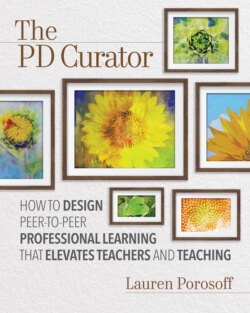Читать книгу The PD Curator - Lauren Porosoff - Страница 16
Structuring Interactions to Promote Learning
ОглавлениеBefore I started working at Topial, I was at a place we'll call the Wile School. At Wile, we didn't have nearly as many meetings as we did at Topial, but teachers' time and space s were structured in a way that encouraged more informal learning interactions.
Wile faculty members who taught in the same department shared an office. As a 6th and 7th grade history teacher, I had a desk in the humanities office. There was a math department office, a language department office, a science department office, a music department office, and so on. The space where I spent most of my nonteaching time was also the space where teachers of English, history, geography, writing, cultural studies, and other humanities courses spent their nonteaching time.
In the humanities office, each of us had a desk, along with shelves where we could store our materials. We also had a small conference room with a round table where we could have longer discussions if we needed quiet. The conference room was lined with books we could all use. Wile's departmental offices were set up as ideal spaces for us to talk about curricular alignment, pedagogical best practices, individual students' growth over time, ideas for projects, and culturally sustaining teaching—so that's what we did. Just as museums structure space for engagement with art, Wile structured space in ways that encouraged conversations about teaching and learning.
At Wile, most faculty meetings were by grade level. Precisely because we didn't share an office but shared students, we needed time to discuss their needs as individuals and to plan grade-level programming such as field trips, special events, assemblies, and our advisory program. We sometimes had department meetings; however, most conversations about curriculum and instruction occurred in our offices. It almost wasn't necessary for us to have formal meetings, because we were together so often.
I say almost because we weren't all together all the time. During any given period, some of us were teaching, meeting with students, or arranging our classrooms. Still, by virtue of spending so much time working near the people who taught the same subject as I did, I had many opportunities to talk about teaching with my peers—and to grow as a designer of learning experiences.
At Topial, I rarely had opportunities to discuss curriculum and instruction as a member of the English department unless I created those opportunities for myself. Faculty offices were grouped by grade level, not by academic department. As a 7th grade teacher, I had a desk in the 7th grade office. Our desks were around the perimeter, facing the walls, so we had our backs to one another when we worked. A small table where we might have worked collaboratively was in the middle of the room, so any conversations held there would have distracted colleagues who needed silence. As a result, the table quickly became a repository for lost items. There were no common bookshelves or materials—only places for our individual belongings.
Topial's 7th grade faculty office's overall setup encouraged large-group conversation, but what were those conversations about? We didn't share a common curriculum; rather, we shared students and a principal, so that was what we talked about. (More accurately, that was what we complained about.) One by one, most of my colleagues decided that they preferred to work in their own classrooms or the library because the faculty offices felt too negative or antisocial. More than one person called them toxic.
Looking back, I wish I had started a conversation about how faculty spaces were designed, how we used those spaces, and what changes we might have made. Even though I didn't have the power to make those changes, I could have proposed them and started the discussion. Changing the space would have been easier than changing our faculty culture, though, because once we associate a place with a particular purpose or set of behaviors, it's hard to relate differently to that space—or relate differently to one another within that space.
Still, the arrangement of a space tells us how to behave there. Just walk into any auditorium; the rows of seats facing a stage or screen tells you you're supposed to sit quietly while watching and listening to whatever is in front of you. Likewise, go into any museum and notice how its designers structured the environment to encourage a particular type of behavior: focused seeing.
Wile structured adult schedules and spaces to encourage teachers to learn from one another in informal interactions. So even though we didn't have many established meetings, we were primed for a peer-to-peer learning program because we were having a lot of those conversations anyway. Building the foundations for peer-to-peer learning isn't just about carving out time for it. It also involves thinking critically about how the school is set up to be a learning environment so the leap to more formalized in-house PD is as small as possible.
Figure 1.2 has a set of questions to help you consider how your school structures teachers' interactions in ways that might encourage (or discourage) peer-to-peer learning. Again, these questions don't have right or wrong answers, but notice any discomfort you feel as you respond, because that might be a signal that your school is not set up in a way that reflects your values.
